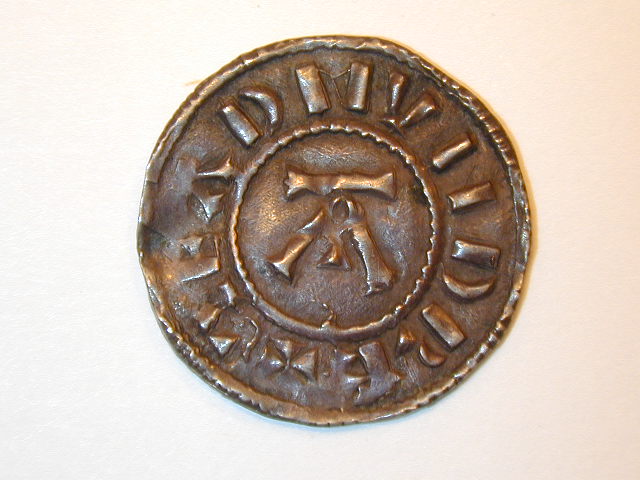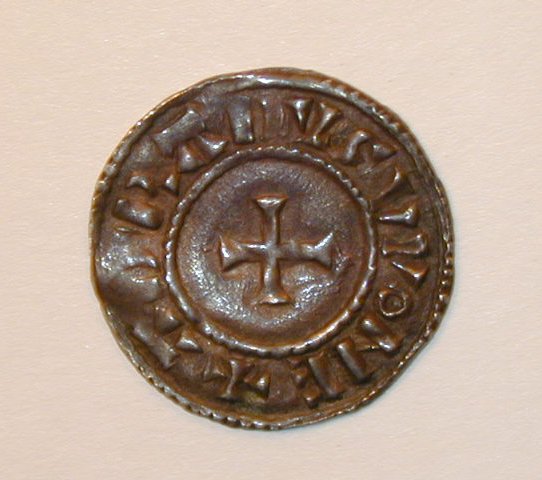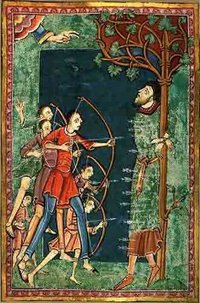Viking "St. Edmund memorial" penny
Perhaps THE classic Viking silver penny made in England, the St. Edmund Memorial penny was issued by the Vikings in Danish East Anglia to appeal to the Christian residents who had come to revere as a saint the former King Edmund. He had been killed by the famous sons of Ragnar Lothbrok, Ivar the Boneless and Ubbe, about twenty years previously, when the Viking Grand Army swept through that part of the country. Although rumours persist that he was killed by the Blood Eagle form of torture, it's likely that he was simply full of arrows, perhaps as a test of the strenght of his Christian religion. The Vikings made serious efforts to live peacefully with the residents of areas in England that they had conquered, and this coin is a perfect example of that sort of effort. The obverse reads SC EADMUND REX around the letter A. The reverse reads ADRADUS MONE (" Adradus made me" using an upside down M). Many examples of this issue display meaningless letters - this one actually provides the name legibly.
The weight is 1.21 grams, made 895 - 910 AD (19 mm) with very attractive dark toning.
Edmund the Martyr (also known as St Edmund or Edmund of East Anglia, died toning. classic was king of East Anglia from about 855 until his death.
Almost nothing is known of Edmund. He is thought to be of East Anglian origin and was first mentioned in an annal of the Anglo-Saxon Chronicle, written some years after his death. The kingdom of East Anglia was devastated by the Vikings, who destroyed any contemporary evidence of his reign. Later writers produced fictitious accounts of his life, asserting that he was born in 841, the son of Æthelweard, an obscure East Anglian king, whom it was said Edmund succeeded when he was fourteen (or alternatively that he was the youngest son of a Germanic king named 'Alcmund'). Later versions of Edmund's life relate that he was crowned on 25 December 855 at Burna, (probably Bures St. Mary in Suffolk) which at that time functioned as the royal capital, and that he became a model king.
In 869, the Great Heathen Army advanced on East Anglia and killed Edmund. He may have been slain by the Danes in battle, but by tradition he met his death at an unidentified place known as Haegelisdun, after he refused the Danes' demand that he renounce Christ: the Danes beat him, shot him with arrows and then beheaded him, on the orders of Ivar the Boneless and his brother Ubbe Ragnarsson. According to one legend, his head was then thrown into the forest, but was found safe by searchers after following the cries of a wolf that was calling, "Hic, Hic, Hic" – "Here, Here, Here". Commentators have noted how Edmund's death bears resemblance to the fate suffered by St Sebastian, St Denis and St Mary of Egypt.
A coinage commemorating Edmund was minted from around the time East Anglia was absorbed by the kingdom of Wessex and a popular cult emerged. In about 986, Abbo of Fleury wrote of his life and martyrdom. The saint's remains were temporarily moved from Bury St Edmunds to London for safekeeping in 1010. His shrine was visited by many kings, including Canute, who was responsible for rebuilding the abbey: the stone church was rebuilt again in 1095. During the Middle Ages, when Edmund was regarded as the patron saint of England, Bury and its magnificent abbey grew wealthy, but during the Dissolution of the Monasteries, his shrine was destroyed. The mediaeval manuscripts and other works of art relating to Edmund that have survived include Abbo's Passio Santi Eadmundi, John Lydgate's 14th century Life, the Wilton Diptych and a number of church wall paintings.
Well. I could have been with these stones until after dark, but as my wife wanted to travel on.. well.. I see you again, some day, hogback stones from Gosforth. And if you happen to be there one day, do not forget that monument on the outside...
Further on with the Cumbrian hogbacktour !
In - yes, luckily again in - St. Peter's church in Heysham, there is a truly beautiful hogback stone. The guide told us, it had been studyied by Thor Ewing, a writer, in 2000. in 'Understanding the Heysham hogback' A tenth century sculpted stone monument and its context (link), Thor Ewing tells in detail what he dicovered on the both sides of this hogback stone.
Just being brought in the church as late as the 1970's accompanied with some protest here and there among the church visitors, considered as being a token of old paganism, it had been remarkably nice preserved, and a lot of detail can be seen, still. Truly worthwile a visit.
I had a small debate with the guide in the church if the - zoomorphic, in my opinion - faces on the sides were lions (or hippo's). The guide doubted if the vikings could have known about lions. Well I guess so, concerning the runes on the Ancient Greek lion statue at the Arsenal, Venice. For example. Vikings did travel south..
But when he told me he was doubting the vikings 'discovered' (as the native inhabitants were of course, in the first place) America before Columbus, I decided to rest my case..
One has to know when to start and to end a conversation ..
Just discovered the book in a bookstore written by Geoff Holder - The guide to the mysterious Lake District, I knew there had to be another hogback stone in Lowther, St. Micheal's Church. With a promising image described in the text of 'a naval and a land-based force of shield-bearing vikings above a fish and what might be a coiled sea serpent. On the reverse is a row of female figures with snakes, possibly a representation of the hideous hag Hel'. Wow. If that did not sound as a true pagan promised land ..
Not complaing too much after all we have seen, this visit was the dissapointing one of them all. But if you wife states 'I am happy to have seen them' and I am answering 'Measuring is knowing' and the even more obligate verb 'handling 'if we did not see it at all, we wouldn't have known anything at all of how they were looking' the glass was again half full, at the last day of our journey..
The hogback stone appeared to be just being tolerated within the entrance segment part of the church. As something you never use anymore but you do not throw away - entirely. That sort of feeling emerged when seeing this hogback asylum seekers.. Bed, bath and bread, ás we say in Dutch, but no luxury at all and standing on some outcuts of wood, you would balance the table with at home..
Come on, St. Micheal's Church.. care a bit more of your 'children' !
This hogback stone was moved in the church in 1907. Hogback stones layed partially buried in the churchyard before it was dug up and moved into the church.
The promising depiction of a longship - as certainly can be seen after some studying - see http://vikingminds.co.uk/pages/longship
we have missed !
The stone itself is (157 x 50 x 30 cm) and very worn.
The hogback stones in Cumbria - very diverse in quality, but everyone worth a visit ! Especially on a gloomy day in late October ...
The churches to visit - see photos of resp. St. Andrew's church in Penrith, St. Mary's church in Gosforth, St. Peter's church in Heysham and St. Micheal's church in Lowther.
Did I miss out on another one in Cumbria ? Let me know !
In a next blog I will take you to four - still remaining utterly mysterious- statues 'guarding' the graveyard of St. Andrew's church in Dacre..
For the last blog of October 9th see this link.
References: (as always, links to where the books can be ordered are attached).
Edwards, B.J.N. Vikings in North West England - The artifacts (1998);
Emery, Gordon, CURIOUS CUMBRIA, The Lake District & Beyond: A celebration of Cumbria (2023)
Ewing, T. 'Understanding the Heysham hogback' A tenth century sculpted stone monument and its context ;
Hall, R. Viking Age archaeology in Britain and Ireland (first printed 1990, reprinted with amendments in 1995);
Holder, G. The guide to the mysterious Lake District (2009)
possibly also (as there within the part of Cumbria dealing with Carlisle, the Eden Valley, Barrow-in-Furness, Whitehaven and the west coast is being dealed with)
Holder, G. Paranormal Cumbria (2010)
http://vikingminds.co.uk/pages/longship


